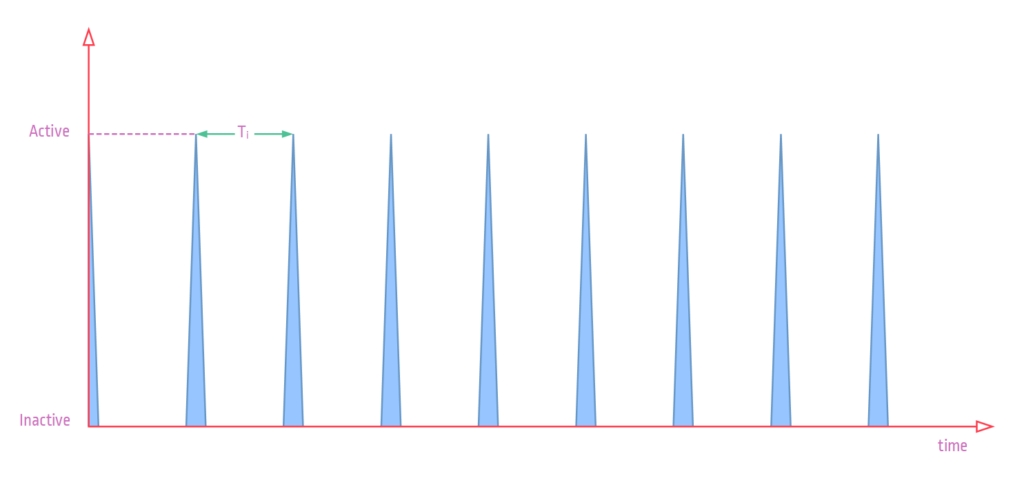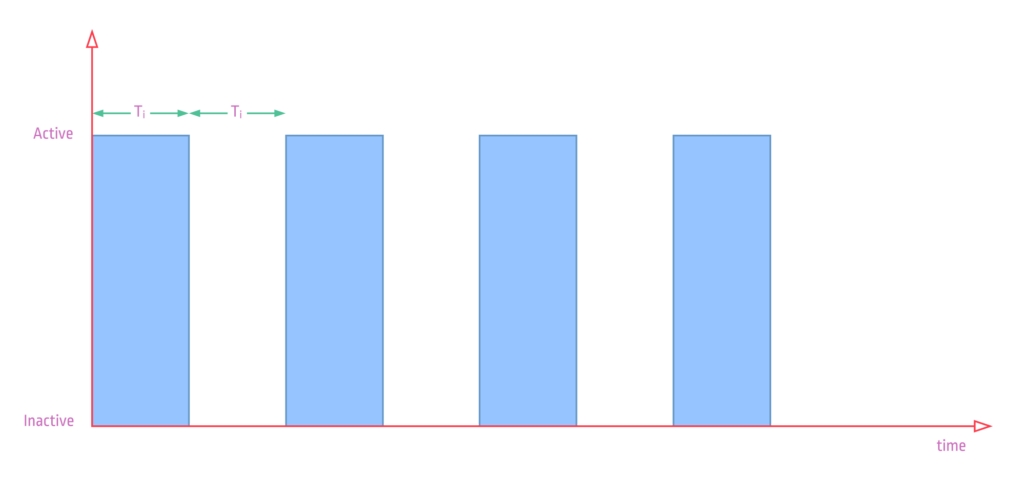How does it work?
Learn how ptScheduler works.
ptScheduler uses the native micros() implementation of Arduino. The micros() function is a timer-based ISR (Interrupt Service Routine) that increments a global counter variable (32-bit unsigned integer) every microsecond. Calling the micros() function will return the current value of the counter. Since Arduino implements the counter as a 32-bit unsigned integer, the counter will overflow every 71.582788266667 minutes. But ptScheduler is written with a workaround to overcome such overflow events and support up to 18446744000000000000 microseconds (584,942.42 years).
When you create a new ptScheduler object, you can specify the time intervals and execution modes. The time interval is stored in a variable or in an array, and is compared to the time elapsed since the last time the task was executed. For example, if the time period for a oneshot task is 1000 milliseconds, the value is stored in a list called intervalList and is compared to the elapsed time every time the associated call() function is invoked. If the elapsed time is less than 1000 ms, call() will return false. If the elapsed time is equal or greater than 1000 ms, call() will return true. This will cause the code under the conditional clause to be executed once. The current value returned by the micros() will now be saved as the new entry point to calculate the elapsed time.
The next time you invoke call() and if the elapsed time is less than 1000 ms, the function will again return false. This kind of task where the code is executed only once after every time interval is called a Oneshot task. You might want to execute a task continuously for a specific time period and then sleep for another time period. It is possible with Spanning tasks. In addition to these basic types of tasks, ptScheduler allows you to alter many other behaviors of a task on the fly.
Let's look in detail how the logic behind task modes and timing work.
Oneshot Task
This is the type of task that is executed only once every time interval. This is useful for tasks such as blinking an LED every second, or printing a message to the serial monitor, or polling a sensor etc. Let's see how a oneshot task with a single interval works.
ptScheduler sayHello = ptScheduler(1000000); //time in microsecondsThe default task mode is
PT_MODE_ONESHOTand the time interval is 1 second. This value is saved as the first value on an interval sequence list. An interval sequence is a set of repeating intervals, saved as an array.When you first invoke
sayHello.call(), the value returned bymicros()will be saved toentryPointvariable. Thecall()will also immediately returntruesince it is the first time we are invoking the task. TheexecutionCounteris incremented from 0 to 1. If you do not want the task to returntruewhen starting the task, you can set a pre-task delay usingsetSkipTime()function. This will cause the task to wait until the skip time is elapsed, before returningtrue.If you invoke
sayHello.call()again within one second of the last call, the value returned bygetTimeElapsed()will be compared against the previously savedentryPointand the difference is saved inelapsedTime. If the difference is less than 1 second,call()immediately returnsfalse. There will be no changes to any other variables at this point.If you invoke
sayHello.call()one second after the first call, the value returned bygetTimeElapsed()is again compared againstentryPoint. The difference is saved inelapsedTimeand if the value is greater than or equal to 1 second,call()will immediately returntrue. It will also save the new value returned bymicros()toentryPointfor the next cycle, resetelapsedTimeto 0, and incrementexecutionCounterby 1.If the
sequenceRepetitionvalue is 0, the above-explained cycle repeats indefinitely. If you want to stop the task after a finite number of cycles, you can setsequenceRepetitionby callingsetSequenceRepetition(<value>)function. The task will automatically suspend or disable itself (determined bysleepMode) after the specified number of repetitions.

During the Active time, the call() will return true, and will return false during the inactive time. Ti is the time interval of the task.
A task can also have multiple intervals in a sequence. Below shows a task with two different intervals T1 and T2.

Spanning Task
Spanning tasks, as the name suggests, span over an interval. The output of a spanning task remains true for one duration and remains false for the next duration. Spanning tasks are useful when you want to continuously perform some operations, in a repeating cycle. Let's see how a spanning task works.
The task mode is
PT_MODE_SPANNINGand the time interval is 1 second. This value is saved as the first value on an interval sequence list. An interval sequence is a set of repeating intervals, saved as an array.When you first invoke
spanningTask.call(), the value returned bymicros()will be saved toentryPointvariable. Thecall()will also immediately returntruesince it is the first time we are invoking the task. If you do not want the task to returntruewhen starting the task, you can set a pre-task delay usingsetSkipTime()function. This will cause the task to wait until the skip time is elapsed, before returningtrue.If you invoke
sayHello.call()again within one second of the last call, the value returned bygetTimeElapsed()will be compared against the previously savedentryPointand the difference is saved inelapsedTime. If the difference is less than 1 second,call()immediately returnstrue. There will be no changes to any other variables at this point.If you invoke
sayHello.call()one second after the first call, the value returned bygetTimeElapsed()is again compared againstentryPoint. The difference is saved inelapsedTimeand if the value is greater than or equal to 1 second,call()will immediately returnfalse. This completes an interval cycle for spanning task. It will also save the new value returned bymicros()toentryPointfor the next cycle, resetelapsedTimeto 0, and incrementexecutionCounterby 1.If the
sequenceRepetitionvalue is 0, the above-explained cycle repeats indefinitely. If you want to stop the task after a finite number of cycles, you can setsequenceRepetitionby callingsetSequenceRepetition(<value>)function. The task will automatically suspend or disable itself (determined bysleepMode) after the specified number of repetitions.



You can have any number of intervals of any length.
Last updated